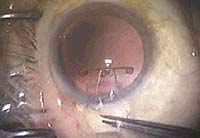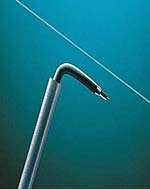Two recent FDA approvals target presbyopia
|
|
Refractec, based in Irvine, Calif., recently received Food and Drug Administration approval for conductive keratoplasty (CK) for correcting presbyopia. The procedure involves the use of radiofrequency energy that is conducted uniformly through the cornea, elevating the temperature around the CK probe to 65°C. A marking is first made on the cornea, and then eight spots are individually placed to create a ring at 6 mm, 7 mm and 8 mm. This allows for uniform transfer of energy, and each band of treatment has a higher correction level.
Candidates for NearVision CK
The procedure appears to be most effective for emmetropic presbyopia, as opposed to hyperopia, and NearVision CK is the first refractive surgery technology to have a presbyopia approval by the FDA.
Ideal candidates are individuals with a refraction of less than +1.00 D who are older than 45 years (average age 54) and require reading glasses only. The majority of patients usually require one eye treatment, although some will benefit from treating both eyes, especially those patients with refractive errors closer to +1.00 D. Other ideal candidates are those who have had myopic LASIK a few years ago and are now emmetropic but are approaching presbyopia. This technology is very effective over previous LASIK and even requires less treatment than on non-treated eyes to achieve the same effect.
Patients should have a minimal peripheral corneal thickness of 560 µm. This procedure has the fewest risks of any refractive surgery because there are no treatments in the visual axis, there is no flap creation and the procedure is not intraocular. The two primary “complications” are the inducement of astigmatism, which often improves greatly with surgical experience and, although extremely rare, no response to the treatment. Although there are few complications, more time is required to set proper expectations, and more handholding is needed postoperatively compared to treatments for myopes. But the same applies to all hyperopic/presbyopic technologies.
Accommodating IOL
The recent approval of the eyeonics (Aliso Viejo, Calif.) accommodating IOL, Crystalens, has added another option to refractive surgery choices for presbyopes. The procedure is the same as cataract surgery in which the crystalline lens is extracted and replaced with an IOL. However, this IOL has the ability to move forward with ciliary body movement and provide near and intermediate capabilities.
The IOL has a hinged optic and two large haptics that fit deep into the capsule. Studies have shown that the ciliary body continues to function, and the movement can propel the lens forward. The hinged optic allows movement forward to provide the seamless range of vision.
Candidates for accommodating IOL
|
|
|
| Eyeonics accommodating IOL: The eyeonics lens has large haptics for insertion deep into the capsular bag and a hinged optic allowing forward motion with ciliary body movement. The photo above shows the lens being inserted through a pupil dilated with atropine. | |
The best candidate is a presbyope with distance trouble (myopia or hyperopia). The plano presbyope is more apprehensive, considering the cost of the procedure. Good candidates are patients with clear lenses, and it is usually better for patients seeking refractive surgery options because the cataract reimbursement rates will not cover the IOL cost. The risks are the same as with any intraocular procedure, including the risk of cystoid macular edema, retinal detachment and dislocation of the IOL.
The accommodative amplitude is about 1 D, but patients appear to see better than that. Patients are very pleased with the results and the ability to see well at distance and near. Depending on IOL calculation success, patients may require fine-tuning of the refractive error with photorefractive keratectomy, CK or another enhancement option. What makes this a good procedure is that it provides the ability to focus at distance and near as the ciliary body contracts. It may simulate accommodation more closely.
Further advances are already occurring, with researchers considering increasing the amplitude of accommodation with dual lens IOLs, for example.
Setting proper expectations
An Internet study asked low hyperopic patients older than 40 years numerous questions; 605 surveys were completed. The study was conducted January 2001 via myclearvision.com, a patient information Web site on vision correction procedures. The results were interesting, as they showed that 69% of all low hyperopes had not considered LASIK as an option. However, this group was not in any way averse to cosmetic surgery, and the basic profile was that of a very active age demographic that wanted to look and feel young. So, what could explain the dichotomy in terms of not wanting LASIK? The answer has to do with the risk tolerance of this demographic.
A 1.00-D hyperope who is in his or her late forties or early fifties will say that he or she always had better vision than any of his or her friends. This hyperope could see a license plate, for example, much sooner than most individuals and took pride in this sharpness of vision. An equivalent low myope, on the other hand, will tell you that he or she has very poor vision and has always had poor vision and that all of his or her friends see better. Obviously, the myopic patient is more likely to take on risk to correct his or her “poor vision,” and the low hyperopic patient is not. Technologies that apply these benefits — such as CK’s low complication rate, no dry eye and no treatment in the visual axis, or accommodating IOLs that are a cataract procedure that is performed millions of times per year — ease some of the anxiety.
Setting short-term expectations
First, we must understand the emmetropic/presbyopic patient’s desires. Because the effect of presbyopia is gradual, patients who may be +1.00 D, for example, will generally not notice the slow loss of distance vision as they age. This is partly because of the gradual onset but also because the near vision loss is so dramatic that it overrides the minimal change in distance.
|
|
Many patients who are +1.00 D may only have 20/30 or 20/40 distance vision when they reach their mid-50s but will be surprised when you inform them of this. Their usual response is that they have always had great distance vision and this is news to them. It is the near that they want help with. They consider reading glasses an indicator of aging only second to gray hair, and they want to feel younger. If we can meet these two needs with a low-risk procedure and set proper expectations, this age demographic is one of the largest patient populations available.
The first expectation to set is the potential for compromising distance vision and informing patients that they may lose a little distance to gain a lot of near. This is usually not the case with either NearVision CK or accommodating IOLs, but it is still better to under-promise. In the first month after NearVision CK, the near treated eye does lose distance vision, but after about 4 to 6 weeks of healing time, the results show very little loss of distance vision and a dramatic improvement in near vision.
This initial distance effect is important for patients to be aware of, as many patients believe that because they have always had great distance vision this will not change. By inducing a small amount of myopia (1.00 to 2.00 D) in CK, you initially lose distance vision. But, fortunately, this is not a typical monovision treatment. A 55-year-old patient with a 1.00-D add should not be able to read J1. The effects of CK are likely a change in higher-order aberrations that occur with increasing the prolate shape of the cornea. This allows for more of a blended vision, and this is why there is very little loss of distance vision after the healing phase, yet a substantial gain in near. Patients must expect about 1 month of healing.
With the accommodating IOL, atropine is used to completely prevent the ciliary body from moving and to allow posterior placement of the IOL. Because atropine can often take days or even weeks to wear off, patients must be aware of the effect on their near vision in the short term as well.
We must also change our testing approach. Because the goal is near vision, patients should be tested with the near chart first, and because of the risk-adverse profile, it is important to show the patient his or her immediate improvement in reading compared to prior to the procedure. Instead of asking how they are seeing (which usually references distance), ask how they are reading.
Setting long-term expectations
Research suggests that a hyperopic shift in refractive error occurs with age unless nuclear sclerotic cataracts develop. For this reason and the unknown long-term results of these relatively new technologies, it is important to let patients know that they may have to be enhanced in the future. It is similar to cosmetic surgery where patients know that their wrinkles will return, but at least they will have gained a number of years and will always look younger than had they not had the procedure.
Statements such “turning back the hands of time,” but not “stopping the clock” appear to assist in patient understanding. Because the effects of capsular fibrosis and a YAG capsulotomy on accommodative IOL movement are still unknown, it is important that patients understand the potential that this may not be a permanent treatment.
The hyperopic progression on CK may also require an enhancement 3 to 5 years later. Setting these expectations, even if they don’t come to fruition, is better than the patient being surprised by the need for another procedure in the future.
Technologies work together
These two new technologies actually work well together in a refractive practice. The cost of the accommodative IOL to the surgeon and then transferred to the patient is considerably higher than the cost of CK, and this allows for a two-tiered pricing system for the correction of presbyopia. Also, the surgery is much more involved for an accommodating IOL, so many surgeons are charging the patient between $4,000 and $5,000 per eye. This also inherently creates a higher expectation by the patient, and many surgeons are including an enhancement to reach emmetropia with CK or PRK as part of the cost.
CK, on the other hand, averages about $1,500 per eye, and many patients require treatment in only one eye. The lower cost inherently creates more realistic patient expectations, and this appears to result in a higher success rate for those patients choosing CK than if only one option and one price point were available. Patients ask more questions to determine which is the best choice for them, and they create expectations based on cost and appear to be happier following either procedure.
Multiple options ranging from multifocal contact lenses to new refractive surgery options allow us to practice at the highest level possible and, most importantly, allow us to fit the best procedure for each patient to optimize outcomes.
For Your Information:
- Refractec Inc. can be reached at 5 Jenner, Suite 150, Irvine, CA 92618; (949) 784-2600; (800) 752-9544; fax: (949) 784-2601; Web site: www.refractec.com.
- Eyeonics Inc. can be reached at 6 Journey, Suite #125, Aliso Viejo, CA 92656; (949)
916-0352; fax: (949) 916-9359; e-mail: Contact@eyeonics.com; Web site: www.eyeonics.com.

![Paul M. Karpecki, OD, FAAO [photo]](/~/media/images/news/print/primary-care-optometry-news/2004/08_august/karpecki_60_90_75431.jpg) Paul M. Karpecki, OD, FAAO, a member of the Editorial Board of Primary Care Optometry News, can be reached at Moyes Eye Center, Barry Medical Park, St. Luke’s Northland Campus, 5844 N.W. Barry Road, Ste. 200, Kansas City, MO 64154; (816) 746-9800; fax: (913) 906-0729;
Paul M. Karpecki, OD, FAAO, a member of the Editorial Board of Primary Care Optometry News, can be reached at Moyes Eye Center, Barry Medical Park, St. Luke’s Northland Campus, 5844 N.W. Barry Road, Ste. 200, Kansas City, MO 64154; (816) 746-9800; fax: (913) 906-0729; 

